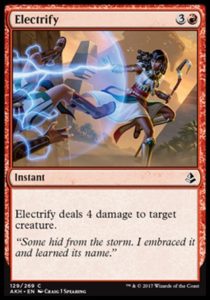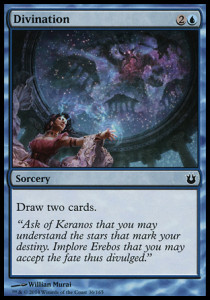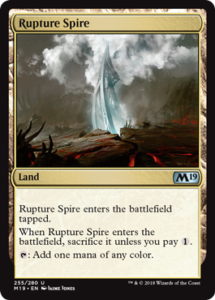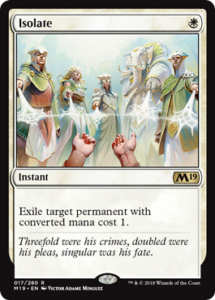I’ve played Magic 2019 a few times and thus far have yet to lose a match. The format is not at all reminiscent of Magic Origins, where Renown creatures like Topan Freeblade forced every deck to be able to act or react by turn two. Frankly, M19 reminds me a lot of Masters 25; where synergy was weak, archetypes were loose, and the format was rife with two-card combos (a comparison that I think is favorable for M19 and unfavorable for Masters 25). The big difference is that Magic 2019’s power level is substantially lower.
Today, let’s discuss what changes in a low power, narrow synergy format.
Removal vs. Creatures
When the power level of creatures is fairly low, cheap removal is usually less important than removal capable of killing major threats. After all, you can just use your creatures to answer your opponent’s (and force a board stall), rather than spend a kill spell. For example, Shock matters less when instead of needing to answer Topan Freeblade immediately, you can easily answer Goblin Instigator and Child of Night with Omenspeaker. The important threats are those like Colossal Dreadmaw, which can only be answered with all-purpose removal like Lich’s Caress, Dwindle, and Luminous Bonds (and notably cannot be answered by any one common red spell and requires something massive for Green to Rabid Bite it with). Find ways for your creatures to blank your opponent’s creatures en masse (spoiler: Gearsmith Guardian is outstanding at this, and just excellent overall) and you can save your removal spells for the things that really matter, like mythic rare Dragons (not named Chromium, the Mutable).
That said, there is an interesting arms race in the format. Goblin Instigator is great against slow strategies but they have cards like Omenspeaker to blank them. These are in turn ineffective against Centaur Courser and Onakke Ogre, which are in turn blanked by cards like Giant Spider and Gearsmith Guardian, which is smaller than Colossal Dreadmaw, which gets blocked by Knight of the Tusk, which runs the risk of being overrun by aggressive decks packing Goblin Instigator. And so the cycle goes. No creature has stats guaranteed to be good against everything you’ll face, so you have to diversify yours to prepare for a wide variety of threats (and sideboard creatures in and out more frequently to respond to what your opponent brings to bear). The format rewards players who have the right creature-threats or creature-answers, forcing their opponent to use removal on regular threats while saving their own for haymakers.
So: if you’re a control deck, blank your opponent’s creatures with your own (where possible). If you’re aggro, have a plan for them to do this. For both, save your removal spells for the things that ruin your plan.
Weak formats reward fundamentals
The lower the power level of a format, the more the games grind out. When synergy is low and streamlined archetypes are difficult to assemble, players in different color combination tend to evaluate cards similarly and decks become goodstuff rather than focused. (This is slightly compensated by the Threshold 1 mechanics of Control One Artifact, Gain Any Life, and Sacrifice Something When You Can, but it also makes it easier for many people to play in this space.) Moreover, when cards are weaker, you’re more likely to win because you have more cards, rather than because you have a single card which just ends the game. Finally, when you do have a game-ending card—like in Magic 2019 sealed, where lots of folks are going to have an Elder Dragon or planeswalker—you really want to find yours before your opponent finds theirs.
All of these factors lend themselves to card advantage being significant. Accordingly, cards like Divination, Marauder’s Axe, and even Aviator Pioneer get better. In addition, when it’s easy to create board stalls, creatures with evasion get much, much better. I’ve been impressed by every single creature with flying in Magic 2019. Sure, Rustwing Falcon is pretty blah, but Skyscanner is disgustingly good.
So: card advantage and evasion are better. BREAD is more relevant than it’s been for a while.
Greed is good
Common dual lands, powerful artifacts and card draw, and powerful multicolor cards enable, encourage, and reward being ambitious with your mana base. It’s harder to be punished for a slow start in slower formats, and insanely powerful cards like Skyrider Patrol and Psychic Symbiont are substantially better than comparably costed commons. Moreover, when cards like Regal Bloodlord and (the less impressive) Satyr Enchanter create easy and effective two-card combos with Fountain of Renewal and Talons of Wildwood (which has a lot of combos), it’s easy to dip your toe into an archetype’s best expression without dedicating your deck to it. As long as you have a plan for aggro—block so that Trumpet Blast/Inspired Charge don’t demolish you and maybe save that Essence Scatter for a 6+ drop—you should be good to go.
So: draft dual lands, draft multicolor cards, and enjoy being greedy.
Magic 2019 appears to be a very control-friendly format (I’ve been playing blue in every event so far, so take my perspective with a helping of skepticism), but one where an unprepared control mage can be overwhelmed by go-wide Inspired Charge deck or an army of Centaur Coursers and Colossal Dreadmaws. There are lot of neat interactions in the format (Talons of Wildwood plus Tormenting Voice being my current favorite) and there’s surprising depth for a Limited format whose target demographic is not enfranchised players. I don’t know how long the format will stay fresh, but I’m enjoying taking M19 slowly and seeing what it has to offer. Despite the format’s overt simplicity, there’s a whole lot beneath the surface.
And, as always, thanks for reading.
—Zachary Barash
Zachary Barash is a New York City-based game designer. He works for Kingdom Death: Monster, has a Game Design MFA from the NYU Game Center, and does freelance game design. When the stars align, he streams Magic.
His favorite card of the month is Metamorphic Alteration. It’s a Clone that you can deploy to Polymorph your opponent’s creature or upgrade your own. It’s not a strong card in and of itself, but it can enable a whole host of shenanigans.





